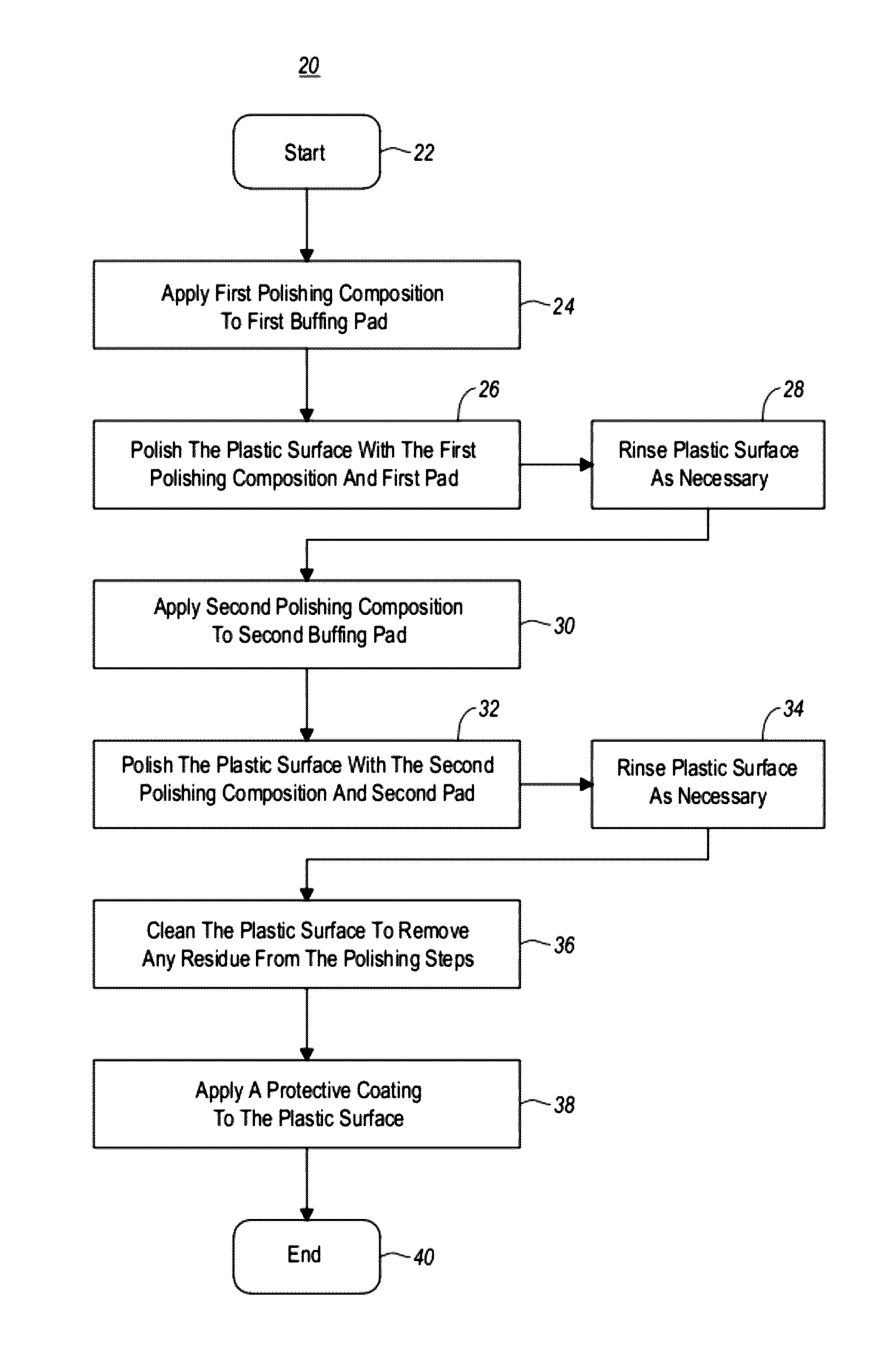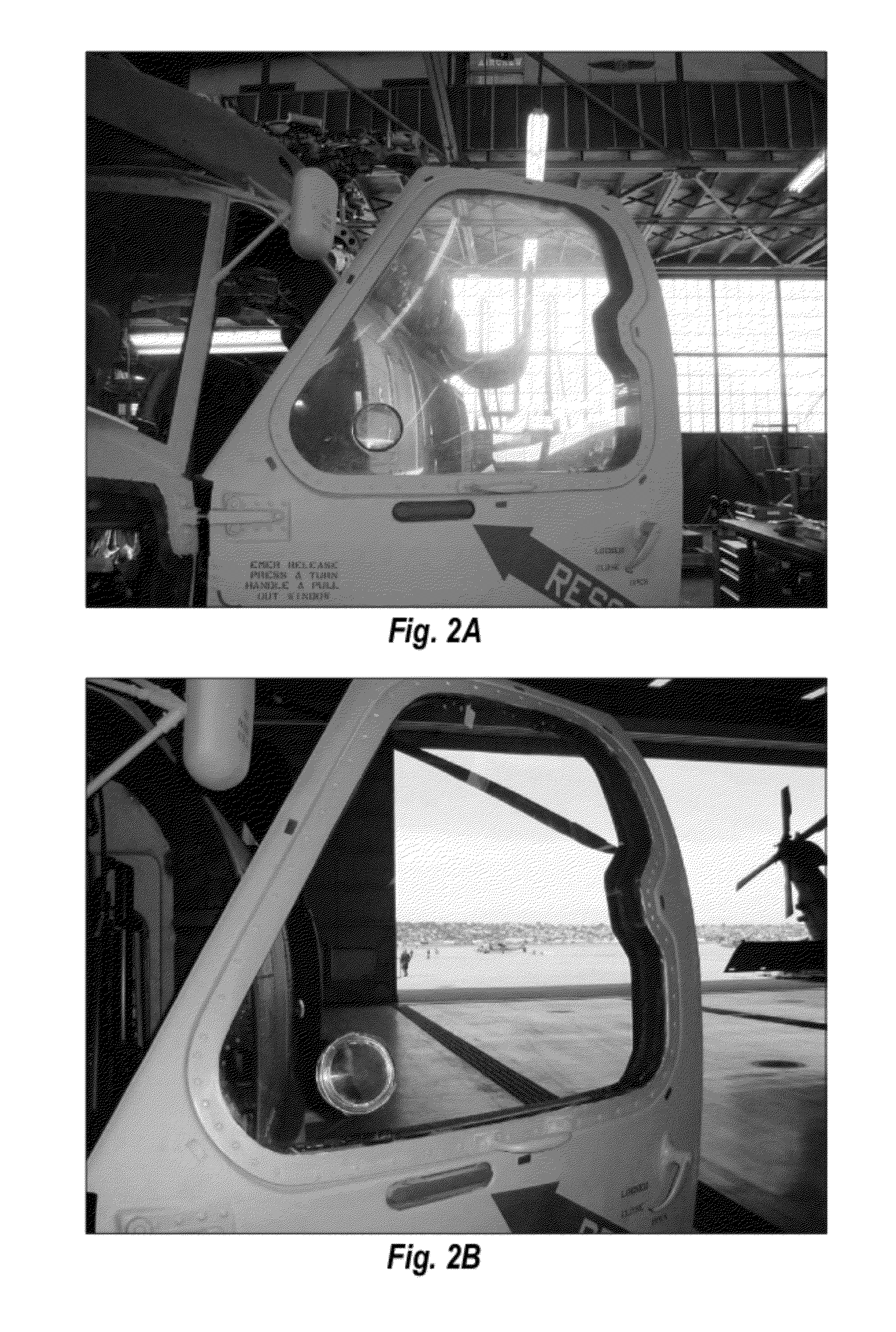UV protective coating composition and method
a technology of protective coating and composition, applied in the direction of manufacturing tools, lapping machines, instruments, etc., can solve the problems of reducing the optical properties of plastic, and not providing 100% protection over time, so as to improve the clarity and optical characteristics of plastic surfaces, restore uv protection to the surface, and improve the optical clarity and light transmission properties
- Summary
- Abstract
- Description
- Claims
- Application Information
AI Technical Summary
Benefits of technology
Problems solved by technology
Method used
Image
Examples
example 1
[0075]A medium abrasive polishing composition including a UV protective material in accordance with the present invention is prepared with the following formulation:
[0076]
% W / WSolid abrasive material30.0Propylene Glycol5.0Carboxymethyl Cellulose1.0Ethylene Oxide / Propylene2.5Oxide Block CopolymerFragrance 981640.21-(3-chloroallyl)-3,5,7-Triaza-1-0.2azonia adamantane chlorideTINUVIN 3840.5TINUVIN 2920.3
Sufficient deionized water is added to bring the total volume to 100 percent (w / w).
[0077]The composition is prepared, packaged, and stored in a substantially oxygen free environment. For example, the dry material is added to a mixing apparatus. Subsequently, the dry materials and the mixer are exposed to a vacuum such that essentially all oxygen is evacuated from the dry ingredients. An inert gas such as nitrogen is added back to the mixing apparatus, the liquid ingredients are added, and the composition is mixed. The composition is subsequently packaged in a substantially oxygen free e...
example 2
[0081]A light abrasive second polishing composition including a UV protective material in accordance with the present invention is prepared with the following formulation:
[0082]
% W / WSolid abrasive material30.0Propylene Glycol5.0Carboxymethyl Cellulose1.0Ethylene Oxide / Propylene2.5Oxide Block CopolymerFragrance 981640.21-(3-chloroallyl)-3,5,7-Triaza-1-0.2azonia adamantane chlorideTINUVIN 3840.5TINUVIN 2920.3
Sufficient deionized water was added to bring the total volume to 100 percent (w / w), which yields a viscous, creamy fluid with a lotion-like consistency. In this and other examples coconut fragrance is added for fragrance purposes only, and it should be understood that fragrance could be omitted or substituted without altering the efficiency of the polishing composition.
[0083]The composition is prepared, packaged, and stored in a substantially oxygen free environment. For example, the dry materials are added to a mixing apparatus. Subsequently, the dry materials and the mixer are ...
example 3
[0086]A heavy abrasive polishing composition including a UV protective material in accordance with the present invention is prepared with the following formulation:
[0087]
IngredientTrade Name / Supplier% W / WMagnesium AluminumVan Gel / RT Vanderbilt30.0Silicate (5% dispersion)Propylene GlycolPropylene Glycol5.0Carboxymethyl CelluloseCMC 7H or CMC1.09M31XF / Aqualon-HerculesAluminum SilicateKaopolite / Kaopolite Co.18.0Fused Silica (8.8 microns average)Siltex 44 / Kaopolite Co.3.0Boehmite AluminaCatapal D / Sasol2.0(60 microns average)(formerly Vista)Ethylene Oxide / Propylene OxideTergitol 15-S-7 / Dow2.5Block CopolymerFragrance 98764Fragrance 98764 / Noville0.21-(3-chloroallyl)-3,5,7-Triaza-Dowicil 750.21-azonia-adamantane chlorideTINUVIN 3840.5TINUVIN 2920.3Deionized Waterq.s. to 100
[0088]This heavy formulation is useful for quick removal of scratches from most plastic surfaces, although it would not likely be used with compact discs, eyeglass lenses or the like. A medium formulation such as set fort...
PUM
| Property | Measurement | Unit |
|---|---|---|
| temperature | aaaaa | aaaaa |
| temperature | aaaaa | aaaaa |
| temperature | aaaaa | aaaaa |
Abstract
Description
Claims
Application Information
 Login to View More
Login to View More - R&D
- Intellectual Property
- Life Sciences
- Materials
- Tech Scout
- Unparalleled Data Quality
- Higher Quality Content
- 60% Fewer Hallucinations
Browse by: Latest US Patents, China's latest patents, Technical Efficacy Thesaurus, Application Domain, Technology Topic, Popular Technical Reports.
© 2025 PatSnap. All rights reserved.Legal|Privacy policy|Modern Slavery Act Transparency Statement|Sitemap|About US| Contact US: help@patsnap.com



